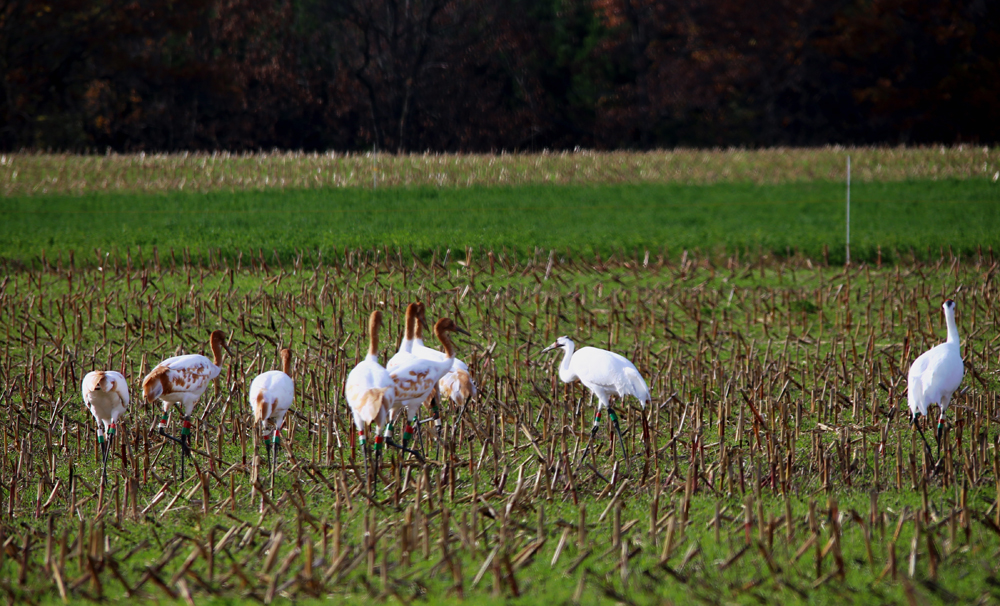by Heather Ray, Operation Migration
October 26, 2017
What differences do you see between the adults on the right
and the 7 younger cranes on the left?
Heather Ray, Operation Migration
October 26, 2017
Now that November is fast approaching, we’re all watching and waiting for the slightest sign that the 18 young cranes in the Eastern Migratory Population will begin heading south from Wisconsin.
Here’s an update about the company the cranes are keeping during this final pre-migration stage. Also, how a Trojan horse helped outfit one adult crane with a new transmitter.
Costume-Reared Chicks: 7 with adult Whooping Cranes
All seven Costume-Reared cranes are still hanging around White River Marsh AND they’re still associating with two adult Whooping cranes: Numbers 5-12 and a Parent-Reared crane from 2016, #30-16. Here’s a picture of them I was able to get just this morning! (See above.)
Parent-Reared Chicks: 7 with Sandhill Cranes
Of the 11 Parent-Reared cranes, 7 are associating with Sandhill cranes. Ideally, we’d prefer them to form a bond with other Whooping cranes but spending time with Sandhills is a very close second choice. Both species have the same habitat requirements and migrate south to spend the cold winter months away from Wisconsin. Quite often, even older Whooping cranes spend time with Sandhills over the winter, so the chance of these young cranes finding another Whooping crane at the wintering location is still very good.
Juvenile Whooping crane #24-17 on the right with his Sandhill crane buddy.
Heather Ray, Operation Migration
Parent-Reared Chicks: 4 with adult Whooping Cranes
Of the 11 Parent-Reared chicks, 4 are associating with adult Whooping cranes. Both are in Marathon County.
Parent-Reared cranes numbers 36-17 & 37-17 are females. The two were released very near to where two male Parent-Reared cranes from the 2016 season have been spending time.
The other two Parent-Reared cranes, numbers 19-17 & 25-17, were the first two chicks released. These two boys were released near two adult female whooping cranes: 2-15 & 28-05 also released in Marathon County. This foursome was seen last week by Brooke Pennypacker and Richard Urbanek from Operation Migration, along with Hillary Thompson and Sabine Berzins from the International Crane Foundation. In fact, they drove up to the area to attempt to capture #28-05 so they could replace her transmitter and draw a small amount of blood for testing.

Two adult male Whooping cranes: Numbers 29-16 & 39-16 seem to have taken a liking to the two younger females: Numbers 36-17 & 37-17.
Hillary Thompson, International Crane Foundation
Hillary said the two adult cranes behaved exactly how we would expect them to react when a ‘threat’ is nearby.
Since they were both costume-reared, Richard, Brooke and Hillary were all in costume for the capture attempt. But wait - #28-05 hadn’t seen a costume for a long time. She was one of the original Direct Autumn Release whooping cranes and it has been 12 years since she saw a costumed handler. How would she react?
The other complication was that these two adult cranes had two Parent-Reared cranes with them and these two had NEVER seen a costume.
It was time to get creative. The foursome had been hanging out in a pasture adjacent a large marsh. They shared the pasture with cows and horses so they were quite familiar with them. The capture team wondered:
“What if we could make friends with that young horse and approach the cranes in costume, with the horse beside us?"
The cranes weren’t afraid of the horse so the team used him
to get close enough to capture 28-05.
Brooke Pennypacker, Operation Migration
It worked like a charm and eventually, number 28-05 was captured with a netgun! Very quickly she was gathered up and a fabric mask/hood was placed over the cranes’ head to reduce stress. The team quickly and quietly remove the old, non-functional radio transmitter and glued a new one in its place.
The entire procedure lasted less than 20 minutes. Then the hood was removed and 28-05 was released to rejoin the other three cranes, including the two Parent-Reared youngsters who had retreated to a safe distance away from the commotion.
These four cranes have been seen together a number of times and we can tell from their remote tracking devices that they are roosting together in the same marsh each night. We hope this bond will continue and the two older cranes will take the younger birds on migration with them to their wintering area.

Juvenile Parent-Reared Whooping cranes 19-17 & 25-17 have bonded with adults 2-15 & 28-05.
Hillary Thompson, International Crane Foundation
It’s beginning to cool off here in Wisconsin and, while it’s still a bit early to head south, we did just receive a report of two adult Whooping cranes at a marsh near Champaign, Illinois late yesterday so it seems the early birds have already begun to head south.
Over and out…
Heather Ray
Operation Migration
- Daily Field Journal: Follow along with Operation Migration as they track the young cranes.



